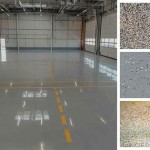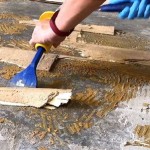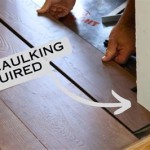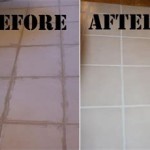Can You Put Vinyl Sheet Flooring on Walls?
Vinyl sheet flooring offers a durable, water-resistant, and relatively inexpensive flooring solution. Its versatility has led many to consider its application beyond the floor. This article explores the feasibility, benefits, drawbacks, and installation process of using vinyl sheet flooring on walls.
Feasibility and Suitability of Vinyl Sheet Flooring for Walls
Technically, vinyl sheet flooring can be installed on walls. However, its suitability depends on several factors, including the wall's surface, the environment, and the specific type of vinyl flooring chosen. Smooth, clean, and dry walls provide the best base for adhesion. Porous surfaces like unfinished drywall or heavily textured walls may require additional preparation or a different adhesive. High-moisture environments, such as showers, may require specialized vinyl and adhesives designed for wet areas.
The weight of the vinyl sheeting is another crucial consideration. Thicker, heavier vinyl flooring can be more challenging to install on walls and may require additional support or a stronger adhesive. For wall applications, thinner, more flexible vinyl sheets are generally preferred. Furthermore, the size and layout of the wall space can influence the installation process. Large, uninterrupted wall expanses simplify installation, while walls with numerous corners, windows, or doors require more intricate cutting and fitting.
Benefits of Using Vinyl Sheet Flooring on Walls
Using vinyl sheet flooring on walls offers several advantages. Its inherent water resistance makes it an excellent choice for areas prone to splashes and moisture, such as bathrooms, kitchens, and laundry rooms. Vinyl's durability makes it resistant to scratches, scuffs, and stains, contributing to its longevity. Compared to other wall coverings like tile or wallpaper, vinyl sheet flooring can be a more budget-friendly option, particularly for large areas.
The wide range of colors, patterns, and textures available in vinyl sheet flooring allows for design flexibility. Whether aiming for a classic, modern, or eclectic aesthetic, there are options to suit various design preferences. Furthermore, the smooth surface of vinyl is easy to clean and maintain, requiring only regular wiping with a damp cloth. This makes it a practical choice for busy households or commercial spaces.
Drawbacks and Considerations for Wall Application
While vinyl sheet flooring can be a viable wall covering, certain drawbacks should be considered. The adhesive used for installation can sometimes release volatile organic compounds (VOCs), which can impact indoor air quality. Opting for low-VOC or VOC-free adhesives can mitigate this concern. Vinyl is not as breathable as other wall coverings, which can potentially trap moisture behind the sheeting if not properly installed, leading to mold or mildew growth.
Wall imperfections can be more noticeable under vinyl sheeting, demanding thorough surface preparation before installation. Temperature fluctuations can also affect vinyl's flexibility and adhesion. Extreme heat can cause expansion, while extreme cold can make it brittle. Finally, removing vinyl sheet flooring from walls can be challenging and may damage the underlying surface, requiring repairs.
Installation Process for Vinyl Sheet Flooring on Walls
Proper installation is crucial for the success and longevity of vinyl sheet flooring on walls. The process begins with thorough surface preparation. The wall must be clean, dry, and free of any dust, debris, or loose paint. Any imperfections should be filled and sanded smooth. For optimal adhesion, a primer specifically designed for vinyl flooring may be applied.
Choosing the Right Adhesive
Selecting the correct adhesive is essential. A high-quality vinyl flooring adhesive designed for wall applications is recommended. Consider the specific type of vinyl, the wall surface, and the environment when choosing the adhesive. Follow the manufacturer's instructions carefully regarding application and drying times.
Applying the Vinyl Sheeting
Careful measurement and cutting of the vinyl sheeting are crucial for a professional finish. Start from one corner and work your way across the wall, ensuring the sheeting is smooth and free of wrinkles or air bubbles. A roller can be used to press the vinyl firmly against the wall and ensure proper adhesion. Trim any excess vinyl using a sharp utility knife.
Finishing Touches
Once the vinyl is installed, allow sufficient drying time for the adhesive to cure completely. Inspect the seams and edges for any gaps or lifting. Seal the edges with a suitable sealant to prevent moisture penetration. Consider using trim or molding to create a finished look and conceal any raw edges.

The Easy Way How To Lay Vinyl Flooring On Shower Walls S1 Ep32

Can You Install Vinyl Flooring On Walls L Antic Colonial

Diy Wood Accent Wall Using Vinyl Planks Love Renovations

Can You Install Vinyl Flooring On Walls L Antic Colonial

Install Vinyl Plank From A Hallway Into Room No Transition Strip

How To Install Sheet Vinyl Flooring

5 How To Install Sheet Vinyl Floor Zerosound 10cm Coved Up On Wall

How To Lay Sheet Vinyl Ideas Advice B Q

10 Things You Can Make With Vinyl Flooring Offcuts Windmill Protea

How To Install Sheet Vinyl Floor Decor Adventures
See Also







